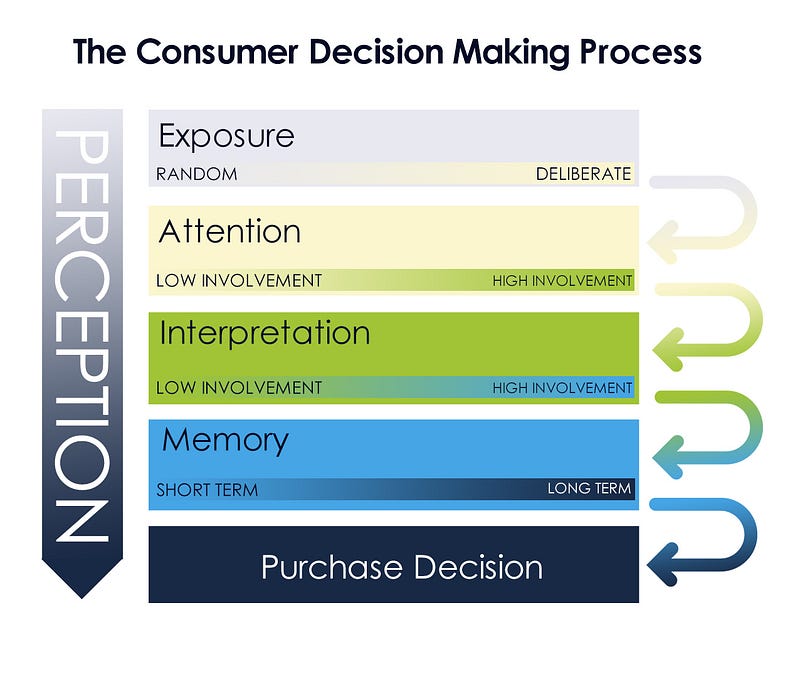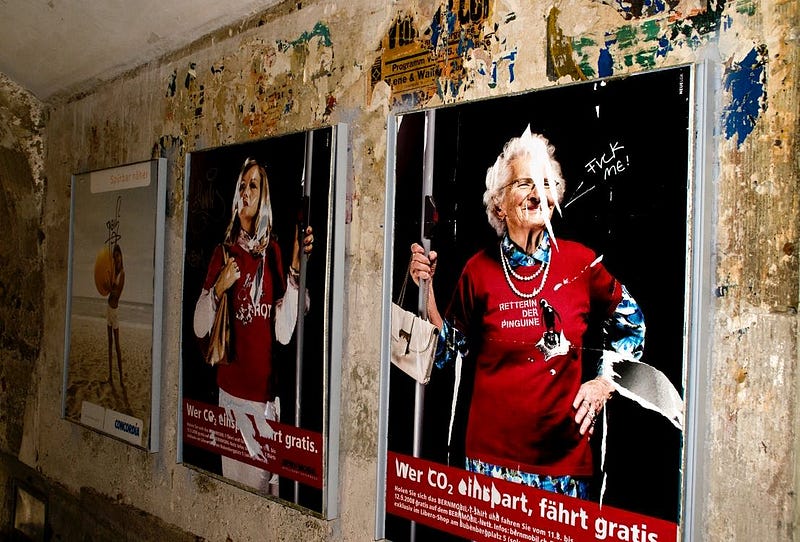Breaking through Perceptual Guards with your Ad Design
“There are more things in heaven and earth, Horatio, Than are dream’t of in your philosophy.” — William Shakespeare
Reality is big.
Really big.
It’s so big that we can barely perceive all of it.
There is so much more information in the world around you that if you would be able to capture it all, you’d probably go crazy. In fact, what you, me, and everyone see, is not really reality, but “a subjective approximation of reality” aka “Perception”.
This perception includes a defense mechanism that prevents us from seeing too much reality. We call this mechanism, “Perceptual Guards” and it keeps us from going crazy by absorbing too much reality.
The Challenge
As Marketers, web developers, and graphic design artists, our job is to break through these perceptual guards alter the our audience’s reality to include our marketing message and influence their decision-making process.
In order to do this, we have to understand the process that makes our audience decide whether they will by our product. What is it’s properties and how does it influence the audience’s perception.
The necessary elements which we must dominate in our ads/websites is mainly focused on Exposure(What they see), Attention(What they look at), and Interpretation (what they “take in”).
EXPOSURE
Exposure for our purposes here is:
“The act of subjecting someone to an influencing experience.”
Part of our goal is to increase the exposure a consumer receives to be able effect our influence on them. How do we do this? Marketing.
If you have enough money, it’s a pretty simple thing. Simply buy ad space in all media and across all places where your audience will be. Of course, most of us have to work within the constraints of a tight budget and must be wiser in our media purchasing habits. Our best bet is to get research that will pinpoint key characteristics of our target demographic.
We have to find out what their habits are, and by deduction what are they now exposed to.
What TV shows do they watch?
What radio stations do they listen to?
What highways do they drive on?
What websites do they frequent?
Once we’ve built an exact profile of our target audience, we can then cater our marketing campaigns to fit within these limits for greatest exposure.
EXAMPLE: Many Affluent households tend to subscribe and watch commercial free television such as HBO or online streaming services. One of the best ways to reach this audience is not through traditional commercials or real ads, but through a more subtle way. To reach this audience, you need to have your product “placed” either in the foreground or background of the real show/movie they are paying attentionto. Product placement has emerged as an effective way to influence the perception of the audience by exposing them to the product in a deliberateway while requiring a low involvement attention and interpretation.
Selective Exposure
We have a finite attention span which necessitates limits on how much attention we can assign to marketing stimuli which we come across. Think about it, if we’re in a car, and the commercials come on, we will use the opportunity to tune it out and talk to each other. Especially if we are not interested in the featured product. Even if we are interested in the product, we won’t put the effort into processing important information such as the location of the advertiser.
How much attention to you give radio ads?
Banner ads?
Pre-roll Videos?
TV Commercials?
Billboards?
E-mail Newsletters?
Direct mail messaging?
Banner ads?
Pre-roll Videos?
TV Commercials?
Billboards?
E-mail Newsletters?
Direct mail messaging?
Not much huh.
Our job as marketers is to be able to break through this exposure barrier and catch AND sustain our audience’s interest enough for them to commit us to memory.
Methods to increase exposure
There are a few of ways we can make sure that we increase exposure to our ads. Regardless of medium, increasing exposure should include the following characteristics:
Repetition — They will eventually see your ad. Repeat it, and they will eventually see your ad. You can’t escape that they will eventually see your ad.
Wide presence — This means placing the same ad across multiple media sources. Putting your ad on multiple TV channels or Radio Stations to make sure that you capture the “channel surfing” audience.
Multiple sources — Advertise your product on combinations of print, radio, TV, Billboards, and websites. Radio combined with strategically placed Billboard increases the likely hood that highway commuters will be exposed to your ad.
ATTENTION
Understanding “attention” and it’s characteristics will allow you to nimbly maneuver and direct your audience. Here are some of the more important characteristics of Attention.
Selective: Attention can be directed towards a certain stimuli or away from it.
EXAMPLE: A person who is not interested in women’s shoes will immediately keep walking past a storefront featuring them without giving it a second thought, while a person who is a fan of shoes and shoe fashion will stop and give it their full attention.
Can be divided: Attention has to be divided into distinct parts. This is an important and even essential characteristic of attention although it has a downside.
EXAMPLE: Your ability to drive while listening to the radio.
The downside of course, is that the more attention you give the driving, the less attention you give other stimuli and may lose our marketing message.
It’s limited: Attention being limited means that we must prioritize what receives our attention.
EXAMPLE: When driving in a crowded street, we may turn down the radio to focus more of our attention to driving.
Grabbing Attention
What determines what receives Attention.
Contrast
More attention is given to stimuli that does NOT blend into the rest of the background “noise”
Stimuli perceived as unexpected will receive more attention.
(Think of alerts. We perceive them as containing potentially important information.)
(Think of alerts. We perceive them as containing potentially important information.)
Beware of Adaptation! Stimuli will eventually become less unexpected the more we experience it and will cause us to assign less attention to it. This is commonly called the adaptation level theory.
Interestingness
Interest is what motivates our allocation of attention towards stimuli. There is an insane amount of competition around us everywhere trying to get our interest.
Information Quantity
Be careful not to overload you audience with information. If it’s too difficult to cope with, you will lose their interest. Make sure you organize your information and streamline your messaging. Make it brief and make it useful.
Self-Relevance
Part of grabbing the audience’s attention, is making your marketing relevant to them. It needs to show the needs values and goals of your audience.
Geography: Are the locations similar to your audience’s sphere? Are they known to your audience.
Similar to oneself: Is the situation you are portraying a situation that your audience can relate to? Does it happen to them? Can they see themselves using the product in real life? Dramatizations is one of the best ways of creating a sense of self-relevance. These ‘dramas’ need to resemble real life.
Rhetorical Questions Only: Make sure that whatever question you ask, you do not need an answer from the audience. Questions work because they tend to stimulate the audience’s attention by creating a link to their own reality.
If the interestingness is executed correctly, then this is the reaction you want to your ad to receive:
“That’s me!”
Pleasant Stimuli
Obviously we all tend to be more attracted to pleasantness. Consumers are no different. This can be achieved through a variety of techniques.
Scenic Backgrounds, beautiful people, symmetry are a few visual elements which you can use to create a much more pleasant experience.
Music can also be used to create a mood elevate pleasantness and enhance stimuli.
Humor is a really great way to create this positive experience. Beware with this one that you don’t overpower the audience with the amusement instead of the product. The humor’s appeal should be strongly tied to the product.
Surprising Stimuli
Surprise is a great way to get attention. If you can create an unexpected situation that will surprise the audience, you will effectively deliver your message. Great way’s to create surprising ads would be to add one or more of these elements to the ad. Novelty, Unexpectedness, a Twist.
INTERPRETATION
The easier it is for your audience to process your message, the more likely it is that he or she will be persuaded and will commit it to memory. This “Cognitive Fluency” is more important than most marketers realize. If your audience perceives the ad to be complicated, then they will believe that your product is complicated. The same is true with brands. If you’ll notice, the bigger brand names are usually short and easy to pronounce.
This is on purpose.
The following are good indicators as to the ease of processing of your ad.
- Prominence of the Ad — The more prominent a stimulus, the more likely it is to be seen. This is why you pay more to be ATF (above the fold)… it’s more prominent.
- Solid simple Message — Concreteness tends to increase attention. Show the entire product to get more attention, as opposed to just part of it which will decrease the ease of processing thus making the ad less effective.
- Contrast it with surrounding stimuli — Contrast refers to the extent to which the stimulus stands out from the environment. A good example would be Transit Buses with wraps. You can get really bold and make the vehicle and the message stand out against an urban background.
- Keep the idea Simple (KISS) Make it look easy. If you want your audience to do something, make sure it’s as easy as possible. Eliminate as many steps as you can between your audience and the marketing goal. Use minimum text, simple fonts and a dark type that will contrast well with the background.
Now that you understand the consumer decision-making process and how your marketing can bypass the perceptual guards to get your marketing message into your audience’s hands. You are now a master at creating truly effective marketing campaigns that will make sure your succeed. Good Luck












Comments
Post a Comment